Background
I answered a question recently in the Project Online General Questions and Answers user forum. The question is one that I have answered many times over my years as a Microsoft Project MVP. The question is usually asked by a project manager who suddenly starts seeing the warning dialog shown in the following figure when opening an enterprise project using Microsoft Project.
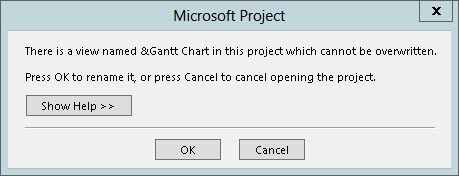
Most project managers assume that they are seeing the preceding warning dialog because they have done something wrong. The answer is the exact opposite: the project manager has done nothing wrong. The culprit is the Project Server administrator, who has accidentally “polluted” the Enterprise Global file with a non-enterprise view.
How Do Local Views Pollute the Enterprise Global?
The problem begins when the Project Server administrator opens the Enterprise Global for editing. There are two actions the Project Server administrator can take which will accidentally pollute the Enterprise Global file while it is open for editing:
- Apply any local view, such as the Gantt Chart view.
- Create a custom enterprise view by copying a local view, such as the Gantt Chart view.
Let me show you how each of these actions will end up polluting the Enterprise Global file with a non-enterprise view.
Apply a Non-Enterprise View
The following image shows the Views page of the Organizer dialog with the Enterprise Global file checked out for initial editing. Notice on the right side of the dialog that the only view currently in the Enterprise Global is the Enterprise Gantt Chart view, which is an enterprise view.
Important Note: The Enterprise Global file should only contain enterprise views and tables, and should never contain any local views or tables, such as the Gantt Chart view or the Entry table.
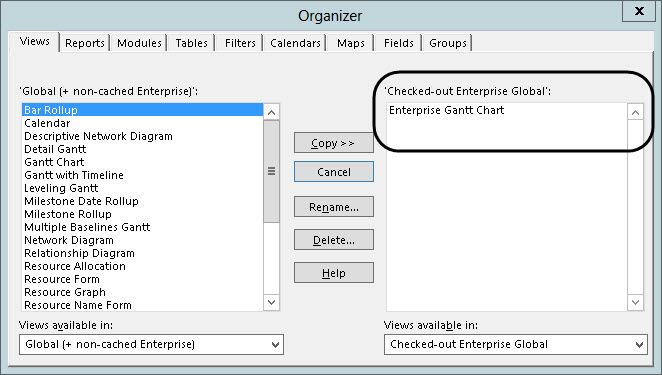
Suppose that I apply the Gantt Chart view, accidentally or intentionally, but then I reapply to Enterprise Gantt Chart view before saving the Enterprise Global. After performing this action, the following figure shows the Views page of the Organizer dialog again. Notice that the right side of the dialog now includes two views: the Enterprise Gantt Chart view and the Gantt Chart view. The Gantt Chart view is a local view, which is now polluting the Enterprise Global file.
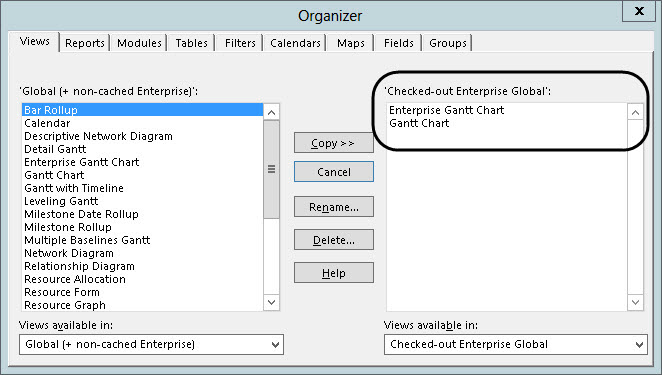
What most people do not realize is that when you apply any local view, such as the Gantt Chart view, Microsoft Project copies the view into the active project. In this case, the active project is the Enterprise Global file. By simply applying a local view (the Gantt Chart view) while the Enterprise Global is open for editing, I have now polluted the Enterprise Global file with a non-enterprise view.
But wait…there’s more. When I applied the Gantt Chart view in the Enterprise Global, I not only polluted it with a non-enterprise view, but I also polluted it with a non-enterprise table as well. The following figure shows the Tables page of the Organizer dialog. Notice that the right side of the dialog now includes the Entry table. The Entry table is a local table, which is now polluting the Enterprise Global file as well.
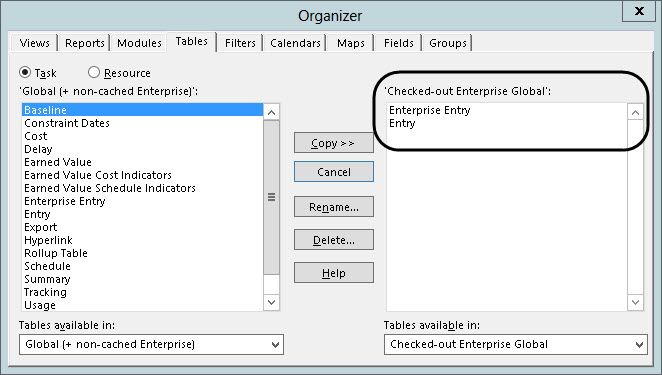
What most people do not realize is that when you apply any local view, such as the Gantt Chart view, Microsoft Project copies the view and its table into the active project. In this case, the active project is the Enterprise Global file. By simply applying a local view (the Gantt Chart view) while the Enterprise Global is open for editing, I have now polluted the Enterprise Global file with both a non-enterprise view (Gantt Chart view) and a non-enterprise table (Entry table).
Create a New View by Copying a Non-Enterprise View
Suppose that I need to create a custom enterprise view to display a custom Critical Path in a Gantt Chart view. Before I create the new view, I open the Enterprise Global for editing. Using the More Views dialog, I make a copy of the Gantt Chart view, I name the new view _Critical Path Gantt, and then I modify the new view.
The following figure shows the Views page of the Organizer dialog after creating the custom _Critical Path Gantt view. Notice that the right side of the dialog now includes three views. The Enterprise Gantt Chart and _Critical Path Gantt views are both enterprise views. The Gantt Chart view, on the other hand, is a local view which is now polluting the Enterprise Global file.
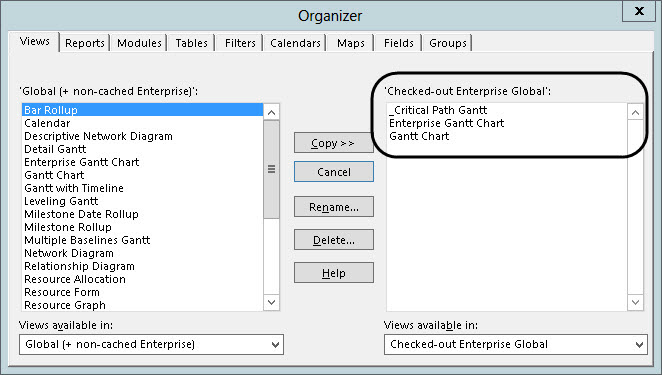
What most people do not realize is that when you create a custom view by copying a local view, such as the Gantt Chart view, Microsoft Project copies the local view into the active project. In this case, the active project is the Enterprise Global file. By making a copy of a local view (the Gantt Chart view), I have now polluted the Enterprise Global file with a non-enterprise view.
The following figure shows the Tables page of the Organizer dialog after creating the new view. Notice that the right side of the dialog includes two tables. The Enterprise Entry table is an enterprise table. The Entry table is a local table which is now polluting the Enterprise Global file.
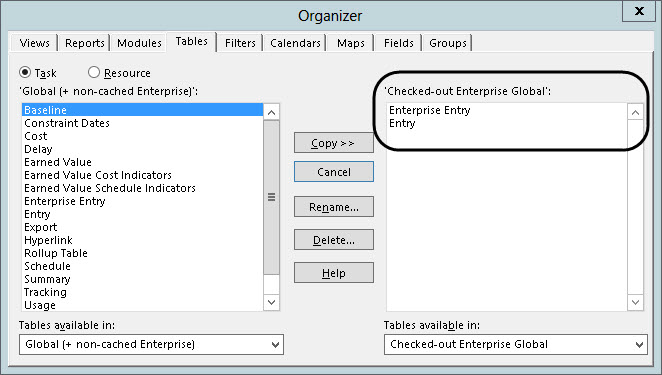
How did the Entry table end up in the Enterprise Global, even though I did not make a copy of it and I never applied it? What most people do not realize is that when you copy any local view, such as the Gantt Chart view, Microsoft Project copies the view and its table into the active project. In this case, the active project is the Enterprise Global file. When I copied a local view (the Gantt Chart view) to create a new view, Microsoft Project copied the Gantt Chart view and the Entry table into the Enterprise Global. Thus, I have now polluted the Enterprise Global file with both a non-enterprise view (Gantt Chart view) and a non-enterprise table (Entry table).
Removing Pollution from the Enterprise Global File
If you are a Project Server administrator, and your project managers begin reporting the error dialog shown at the beginning of this blog post, then you must delete non-enterprise views and tables from the Enterprise Global file. To do this, first open the Enterprise Global file for editing, and then click File > Info . Organize Global Template > Organizer. On the right side of the Organizer dialog, select each non-enterprise view and click the Delete button. Notice in the following figure that I am preparing to delete the non-enterprise Gantt Chart view from the Enterprise Global.
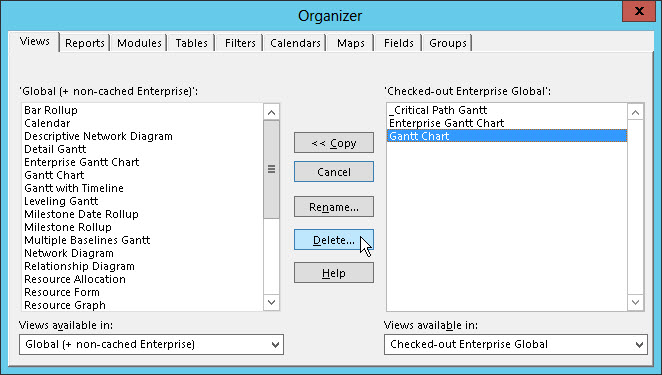
When you attempt to delete a view using the Organizer dialog, Microsoft Project will always display a confirmation dialog similar to the one shown in the following figure. Confirm the deletion by clicking the Yes button in the dialog.
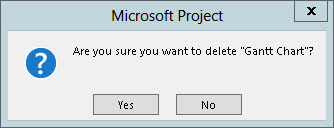
After deleting non-enterprise views, you must also delete non-enterprise tables. To do this, click the Tables tab in the Organizer dialog. On the right side of the Organizer dialog, select each non-enterprise table and click the Delete button. In the confirmation dialog, click the Yes button. When finished, click the Close button to close the Organizer dialog.
Save, close, and check in the Enterprise Global. Exit Microsoft Project and relaunch the software. You must also ask your project managers to exit Microsoft Project and relaunch the software as well, which will eliminate the warning dialog shown at the beginning of this blog post.
Did this blog post help you? Would you like to learn more about how to effectively use Microsoft Project, Microsoft Project Server, or Project Online to manage your projects? If so, please consider enrolling in one of our upcoming open enrollment training classes.
You can take our training classes “in person” in our EPMA training center in Houston, Texas or “live-virtual” over the Internet. And don’t forget to follow us on Twitter, LinkedIn, and Facebook.
For more details & kick start your project management journey, sign up for our Microsoft Training Classes or send us an email.
I hope you find this blog post helpful. For more tips and tricks on Project Management, please visit www.epmainc.com

